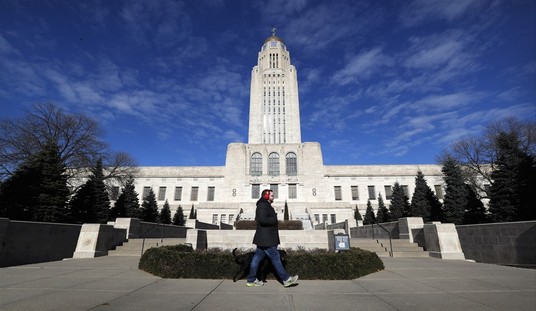America is far more tolerant today than it ever has been. This is a disaster for the progressive movement, New York Times bestselling author David Freddoso explains in the March issue of Townhall Magazine, which is forcing wannabe heroes to create their own alternative reality.
In December, a legion of liberals in the San Francisco Bay area staged a series of protests against the tech companies that provide California’s lifeblood. They staged blockades of the private buses that companies like Google and Apple use to shuttle employees to work in Silicon Valley each morning. In one Oakland confrontation, they even shattered a bus window. Their message: Tech workers are moving in and driving up the price of housing.
Whatever the merits of their secessionist movement, the protests produced one of the great viral events of 2013. On December 9, as protestors blockaded a Google bus on Valencia Street in San Francisco, a man with the convincing appearance of a Google employee approached the protestors and began berating them for their lowly social status:
Google Employee: If you guys would just move out of the way...
Protestor: How long have you lived in the city?
Google Employee: Look, I’ve been here for six months, OK. Look, I live around the corner. I don’t owe you anything.
Protestor: How much is your rent?
Google Employee: Look, I can pay my rent. Can you pay your rent? Can you pay your rent?
Protestor: I can’t pay my rent.
Google Employee: Well, you know what, why don’t you go to a city where you can afford it? You know, this is a city for the right people who can afford it. If you can’t afford it, it’s time for you to leave...I’m sorry, I’m sorry, it’s time for you to leave. Look, if you can’t pay your rent, I’m sorry. Get a better job....
A rather outrageous thing for a Google employee to say in front of reporters, with cameras rolling. But of course, it wasn’t a real Google employee at all. It was a union organizer named Max Alper, who was involved in the protests and staged the entire confrontation for their benefit. And for the benefit of the cameras, of course.
Naturally, the media lapped it up. The story spread instantly all over the Internet. The video had already become a sensation by the time another union organizer, perhaps concerned about the potential for such a hoax to backfire, tipped off the San Francisco Bay Guardian that the incident had been fake.
ALL THE HATE THAT’S FIT TO FAKE
Oberlin College in Ohio probably seems an unlikely haven for Nazis and racists, but last February, someone was terrorizing the campus with racist graffiti, flyers, and emails sent from a fake address using the name of the school’s president. Someone even placed a flag with a swastika in a campus building.
The incidents received national news coverage, but their resolution did not... at least not until The Daily
Caller News Foundation obtained the alleged perpetrators’ names through a state open records request. The college’s administrators had discovered within a week that it was a hoax, put on by an overzealous and outspokenly liberal President Obama campaigner and his friend. The supposed mastermind, Dylan Bleier, was a member of a left-wing group called White Allies Against Structural Racism. After quietly expelling and removing the perpetrators from campus, administrators concealed their knowledge that it had all been fake, leaving other students to live for months in needless fear of their surroundings.
Such incidents occur surprisingly often in today’s America. The Google and Oberlin hoaxes of 2013 were simple, blunt attempts by agitators to create false fears among their peers. One could say the same of feminist blogger Meg Lanker-Simons, who plead no contest in October after reporting rape threats against her. She had in fact posted them to herself on Facebook using a dummy account.
Some people aspire to create problems that make the world seem awful, and then promote their own politics as the solution. Other hate-crime hoaxes are not so straightforward in their motivations, but they are nonetheless received in the same way. For example, Joseph Baken of Montana claimed in 2012 that he’d been beaten up because he was gay, but it turned out he was just too embarrassed to admit he’d messed up his own face with an attempted backflip while drunk. Alicia Hardin, a student at Trinity International University in Illinois, faked a series of threatening, racist notes to fellow black students in 2005, apparently in an attempt to frighten her parents into letting her transfer to another college.
Whatever their origin, these supposed hate incidents provide instant fodder for the overly imaginative and routinely get hoaxers all kinds of favorable attention. The stories prove so dangerously attractive, especially to liberal journalists and academics, that they are simply too good to check before publicizing, no matter how implausible they seem on their face.
THE GRIEVANCE DEFICIT
Real hate crimes occur in America every year. Some of them are even violent. The fact that many of the most ostentatious ones turn out to be fake does not make the real ones any less serious.
But the endurance of the hoax hate crime as a genre says quite a bit about the times we live in, and how much less threatening they are than ages past. America has become a better place over time, where people are less petty and ignore differences of race and class. But this very improvement has created a “grievance deficit” that produces perverse results in our culture and politics.
Over the last seven decades, the United States has made huge progress in fighting both institutional and personal bigotry. For nearly everyone under age 60, and for many older than that, it’s hard even to imagine how bad things once were. This is especially true with respect to racial hatred. Racism has obviously not disappeared, but consider that your grandparents, when still young, looked on as it was enforced through heavy- handed state compulsion, lynchings, disenfranchisement, and socially accepted terrorism.
Thankfully, such horrors are a distant memory. Today’s America has twice elected a black man as its president, and black men and women alike have risen to top positions of authority in all three branches of the federal government and both major political parties. Gallup polling shows that Americans of all political persuasions are increasingly satisfied with the state of race relations. Satisfaction is substantially higher (up 11 points to 55 percent), and dissatisfaction substantially lower (down 13 points to 35 percent) than when the question was first asked in 2001.
And perhaps most importantly, today’s young would literally rather be called anything other than racists. Though once codified in our laws and backed up by a wink, a nod, and a truncheon, the old hatreds have been rightly shamed into the shadows, whence they dare not show their faces for fear of the righteous anger they arouse.
This is an undeniably positive development for the nation. But for the would-be liberal hero, it is a catastrophe, a full blown identity crisis. And that’s why we see hoaxes work, time and again.
LIBERAL HERO WANNABES
Like Don Quixote, the would-be hero finds himself living in the wrong era, a world in which the true heroism of storybooks no longer seems possible. He has read of MLK and the Freedom Riders and Bloody Sunday in Selma. Next to them, the causes for which he would fight today (abortion on demand, greater government control of the economy, higher taxes) are so much less noble than the old ones, whose hardest parts were won by better men.
Had he lived back in the day, perhaps our hero would have bravely faced the firehoses, bombings, and beatings. Or perhaps not. Either way, he can only relive those days now in his imagination, by inflating the threats that he thinks surround him. He cannot accept that Americans, though imperfect, are good and decent people, or that America is a good and decent nation. He is short of real grievances, and eager to re-enact (with much lower stakes, of course) the far more glorious battles of ages past.
This is where hoaxers and hysterical liberal pundits come in. They facilitate the creativity of minds thus afflicted with this “grievance deficit disorder.” In cases like Oberlin and the Google shuttle, their behavior is a function of supply rising to meet demand. It was easy for Andrea Brazier of Lunenburg, Massachusetts, to land an appearance on Piers Morgan’s CNN show because hers was the kind of story Piers Morgan likes. She seemed to be a hate-crime victim. She is now suspected of spray-painting her own home with racist messages and then accusing high school football players who had supposedly hazed her son. She was discovered only after the team canceled the last two games of its season.
Dayna Morales, the waitress in New Jersey who famously faked an unkind note from a customer about her own sexuality, quickly landed several news interviews and received thousands of dollars in cash from well-wishers, before she was discovered to have made everything up.
FAKE BUT ACCURATE
Supply and demand. These deceptions exist because delusion and paranoia allow them to flourish. After the Google hoax, The Atlantic’s Sarah Goodyear wrote a piece titled, “Why I’m Not Embarrassed to Have Been Fooled by the Google Bus Protest Hoax.” The point of this follow-up was that San Francisco is so rife with hatred of the working classes (the very phrase seems both foreign and old-fashioned) that one can hardly be blamed for taking the hoax at face value.
“What Alper said was off the charts, insensitivity-wise, and in retrospect it’s easy to say that more people should have called B.S. on it sooner,” Goodyear wrote. “But it seemed enough like something someone might actually say...that it fooled a lot of people, at least briefly (I will confess to being one of them).”
To put it another way, hate-hoaxes are fake but accurate. With the omnipresence of hate taken as a given, deceptions that increase awareness of hate are ipso facto credible. Perhaps even justifiable.
Such hoaxes are the clearest illustration of what the relative dearth of haters is doing to a few creative souls on the Left. But they are by no means the only illustration. Unfortunately, the problem of grievance deficit disorder goes much deeper into our public conversation than the occasional high-profile hoax.
IF THEY COULD TURN BACK TIME
For those itching to see the hand of evil everywhere, it is especially easy to transfer it to one’s own political opposition. How else does one explain MSNBC’s Chris Matthews’ comments earlier this year. That if Republicans take full control of Congress in the 2014 midterm election, it will pave the way to a return to Jim Crow?
“It will be a double-downing [sic] of efforts to suppress the votes of those who voted for him in historic numbers, the return to something like Jim Crow days, relevant of all the old anti-black gimmickry of that time... literacy tests and poll taxes and all the rest. The goal will be to erase not just Obama from the history books, but any evidence that someone of his background should ever think of being president. It will mean victory for the haters.”
Matthews seemed to be referring here to requirements that voters present identification, something with broad popular support, used in nearly every nation except our own, and which no study has ever shown to discriminate against or suppress votes among any particular racial group.
But Matthews doesn’t need much of an excuse to do this. In fact, there may not be anything Matthews disagrees with that cannot somehow be linked to Jim Crow. In April 2013, he compared senators who opposed gun control to Jim Crow. In July 2011, he linked abortion restrictions in Kansas to Jim Crow. One can only wonder what people who actually experienced the Jim Crow South would say about the flippant nature of his frequent comparisons.
Matthews is by no means alone among America’s high- profile liberal pundit class in trying to outlaw dissent from his own opinions as a form of hatred. Salon columnist Joan Walsh wrote that the October government shutdown was the result of “50 years of GOP race-baiting,” and also asserted that even mere references to limited government are just manifestations of veiled racism.
SHUTTING DOWN DEBATE
The Daily Beast’s Michael Thomasky argued that even Republican criticisms of Obamacare’s Medicare cuts were a form of racism, an insinuation that Obama was taking away from a program white people use to fund a program black people would use. For liberal columnist David Sirota, the most important question after the Boston Marathon bombing last April was that the bombers be of a particular race, white preferably. Because then white people may be forced to come to grips with ideas of collective guilt...or something. Because in the end, if the perpetrator had been of any other race, we could all be counted on immediately to assume that everyone in that group is somehow responsible.
These three writers I’ve cited as examples all support Obama uncritically. But assuming they believe at least some of their own claptrap, they must have a very odd conception of what it means that we’ve twice elected a black president. People criticize and oppose him, sometimes even unfairly, something that has surely never happened to any white president. For these liberal pundits, Obama’s election, far from demonstrating that Americans can overlook racial differences, has instead turned racism into a novel and convenient explanation for every setback and all opposition their own worldview faces. And this has the side benefit of making their struggle seem noble and their adversaries evil.
The lusty embrace of this crutch to explain away and shout down all other opinions has perhaps turned liberalism into the greatest casualty of grievance deficit disorder. To operate under the assumption that half of Americans are natural haters is to close one’s mind to reality and reason. And it shows.
Older Americans have overcome a great deal in their lifetimes, and younger Americans are forward-thinking people who now stand on their shoulders. As time goes on, the scarcity of genuine grievances will intensify. Our nation’s future won’t give the time of day to pettiness or waste energy on irrational hatreds.
And yes, the hoaxes and hysteria may continue. But Americans can at least be grateful for the progress we’ve made in making hate a four-letter word. As long as hoaxers and self-interested wolf-criers in our pundit class don’t succeed in dulling our senses completely to true manifestations of hate, America will only become an even better place. •
David Freddoso, a New York Times bestselling author, is editor of the Conservative Intelligence Briefing and a columnist for the Washington Examiner.

























Join the conversation as a VIP Member